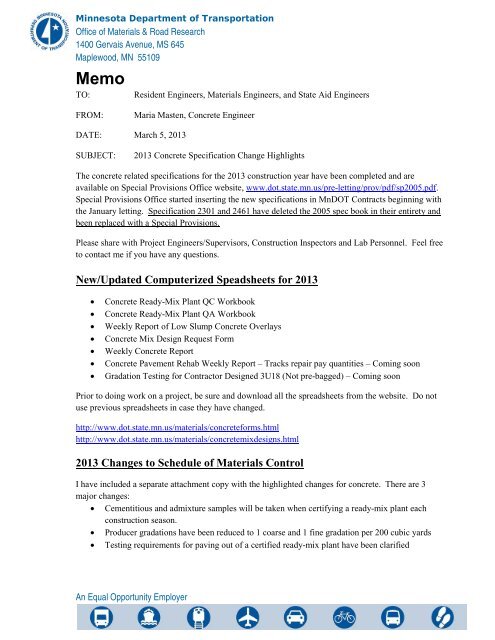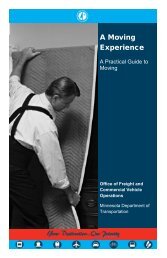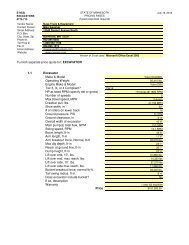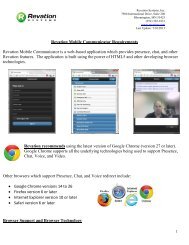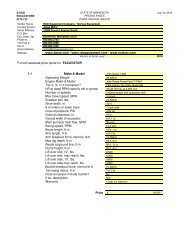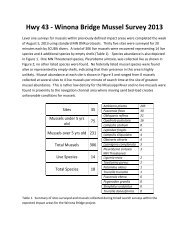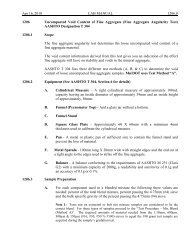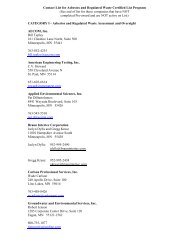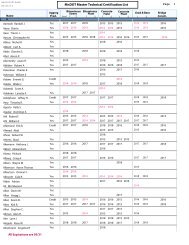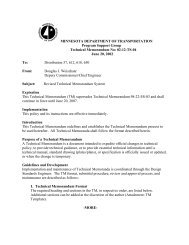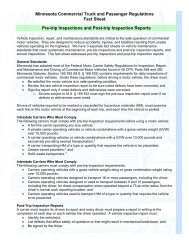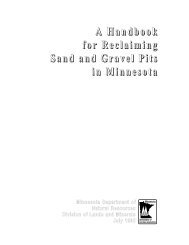2013 Spec Change Summary Concrete - Minnesota Department of ...
2013 Spec Change Summary Concrete - Minnesota Department of ...
2013 Spec Change Summary Concrete - Minnesota Department of ...
Create successful ePaper yourself
Turn your PDF publications into a flip-book with our unique Google optimized e-Paper software.
<strong>Minnesota</strong> <strong>Department</strong> <strong>of</strong> Transportation<br />
Office <strong>of</strong> Materials & Road Research<br />
1400 Gervais Avenue, MS 645<br />
Maplewood, MN 55109<br />
Memo<br />
TO:<br />
Resident Engineers, Materials Engineers, and State Aid Engineers<br />
FROM:<br />
Maria Masten, <strong>Concrete</strong> Engineer<br />
DATE: March 5, <strong>2013</strong><br />
SUBJECT:<br />
<strong>2013</strong> <strong>Concrete</strong> <strong>Spec</strong>ification <strong>Change</strong> Highlights<br />
The concrete related specifications for the <strong>2013</strong> construction year have been completed and are<br />
available on <strong>Spec</strong>ial Provisions Office website, www.dot.state.mn.us/pre-letting/prov/pdf/sp2005.pdf.<br />
<strong>Spec</strong>ial Provisions Office started inserting the new specifications in MnDOT Contracts beginning with<br />
the January letting. <strong>Spec</strong>ification 2301 and 2461 have deleted the 2005 spec book in their entirety and<br />
been replaced with a <strong>Spec</strong>ial Provisions.<br />
Please share with Project Engineers/Supervisors, Construction Inspectors and Lab Personnel. Feel free<br />
to contact me if you have any questions.<br />
New/Updated Computerized Speadsheets for <strong>2013</strong><br />
• <strong>Concrete</strong> Ready-Mix Plant QC Workbook<br />
• <strong>Concrete</strong> Ready-Mix Plant QA Workbook<br />
• Weekly Report <strong>of</strong> Low Slump <strong>Concrete</strong> Overlays<br />
• <strong>Concrete</strong> Mix Design Request Form<br />
• Weekly <strong>Concrete</strong> Report<br />
• <strong>Concrete</strong> Pavement Rehab Weekly Report – Tracks repair pay quantities – Coming soon<br />
• Gradation Testing for Contractor Designed 3U18 (Not pre-bagged) – Coming soon<br />
Prior to doing work on a project, be sure and download all the spreadsheets from the website. Do not<br />
use previous spreadsheets in case they have changed.<br />
http://www.dot.state.mn.us/materials/concreteforms.html<br />
http://www.dot.state.mn.us/materials/concretemixdesigns.html<br />
<strong>2013</strong> <strong>Change</strong>s to Schedule <strong>of</strong> Materials Control<br />
I have included a separate attachment copy with the highlighted changes for concrete. There are 3<br />
major changes:<br />
• Cementitious and admixture samples will be taken when certifying a ready-mix plant each<br />
construction season.<br />
• Producer gradations have been reduced to 1 coarse and 1 fine gradation per 200 cubic yards<br />
• Testing requirements for paving out <strong>of</strong> a certified ready-mix plant have been clarified<br />
An Equal Opportunity Employer
<strong>2013</strong> <strong>Concrete</strong> <strong>Spec</strong> <strong>Change</strong>s<br />
Page 2 <strong>of</strong> 7<br />
2301 <strong>Concrete</strong> Pavement <strong>Change</strong>s<br />
2301.3.A.6 MIT-SCAN T2 Non-Destructive Testing Device<br />
The Contractor shall furnish a MIT-SCAN T2 non-destructive testing device having the ability<br />
to measure the location <strong>of</strong> concrete reinforcement, dowel bars and concrete pavement thickness in a<br />
single device. Agency and Contractor personnel shall mutually use this non-destructive testing device<br />
several times a day during concrete pavement construction.<br />
The Contractor shall perform the following in the hardened concrete:<br />
(1) For transverse joints the entire paved width<br />
(1.1) On first day, Scan one joint out <strong>of</strong> every five joints to verify dowel bar alignment and<br />
process.<br />
(1.2) If first day is acceptable, scan one joint out <strong>of</strong> every 500 feet as well as scan one joint<br />
out <strong>of</strong> every five joints on a 500 foot random segment each day for the remainder <strong>of</strong><br />
the project.<br />
(1.3) If a joint is found to have dowel bars out <strong>of</strong> acceptable alignment tolerances, scan<br />
joints on both sides until alignments meets acceptable tolerances.<br />
(2) For longitudinal L1T joints<br />
(2.1) On first day, scan 75 feet out <strong>of</strong> every 1000 feet, as well as scan one 500 foot random<br />
segment, to verify tie bar alignment and process.<br />
(2.2) If first day is acceptable, scan 75 feet out <strong>of</strong> every 5000 feet as well as scan one 500<br />
foot random segment each day for the remainder <strong>of</strong> the project.<br />
(2.3) If a panel is found to have 2 or more tie bars missing or out <strong>of</strong> acceptable alignment<br />
tolerances, scan joints on both ends until 5 consecutive panels meets acceptable<br />
alignment tolerances.<br />
Contact the <strong>Concrete</strong> Engineer for recommendations if alignment tolerances are not met.<br />
Agency observations do not relieve the Contractor <strong>of</strong> the requirement to properly place the<br />
concrete reinforcement and dowel bars as shown in the plans. In addition, the <strong>Department</strong> reserves the<br />
right to reject the pavement in accordance with 1503, “Conformity with Plans and <strong>Spec</strong>ifications” and<br />
1512, “Unacceptable and Unauthorized Work.”<br />
The Engineer will not provide additional payment for furnishing the above equipment for the<br />
<strong>Department</strong>'s use.<br />
Comments on spec change: The Contractor’s felt we were asking for more testing from them<br />
than was necessary. They proposed a minimum testing rate on the hardened concrete and this is<br />
the final resolution. We still reserve the right to test more and the <strong>Concrete</strong> Unit has 4 MIT-<br />
Scan T2’s that can be used during <strong>2013</strong> construction.<br />
2301.3.E.2 <strong>Concrete</strong> Ingredient Summaries<br />
If delivering bulk cementitious materials directly to the concrete batching plant in railroad cars or<br />
sealed transport trucks, submit copies <strong>of</strong> the bill <strong>of</strong> ladings to the Engineer on the same day received<br />
from the transporting company.<br />
An Equal Opportunity Employer
<strong>2013</strong> <strong>Concrete</strong> <strong>Spec</strong> <strong>Change</strong>s<br />
Page 3 <strong>of</strong> 7<br />
Advise the Engineer <strong>of</strong> the method and schedule <strong>of</strong> cementitious material unloading. Do not<br />
unload cementitious materials until the Engineer approves the operation.<br />
Each day <strong>of</strong> concrete pavement production, provide the Engineer with a production summary in an<br />
electronic format that includes the following:<br />
(1) Daily total concrete produced in cubic yards for each concrete mixture type.<br />
(2) Daily total ingredient quantities (aggregate, cementitious and water) including the percent<br />
overrun/underrun.<br />
The Contractor shall provide final project total quantities for (1) and (2) to the Engineer at the end<br />
<strong>of</strong> the Project.<br />
Comments on spec change: We have deleted the requirement for Contractor cement cut-<strong>of</strong>fs.<br />
We will use the daily material summaries for verification <strong>of</strong> materials, printed from the batch<br />
plant computer.<br />
2301.3.F.2 Air Content<br />
Maintain the air content <strong>of</strong> Type 3 paving concrete at the specified target <strong>of</strong> 7.0 percent<br />
±1.5 percent <strong>of</strong> the measured volume <strong>of</strong> the plastic concrete before consolidation in accordance 1503,<br />
“Conformity with Contract Documents.”<br />
Comments on spec change: Clarified the Target Air Content <strong>of</strong> 7% for paving is BEFORE<br />
CONSOLIDATION. The Air Content after the Air Loss Correction Factor (ACF) needs to be<br />
maintained above 5.5%. For example, if the air content before consolidation was 7% and the air<br />
content behind the paver was 5% using an ACF <strong>of</strong> 2%, the Contractor would be required to<br />
increase the air content before consolidation to a minimum <strong>of</strong> 7.5%.<br />
2301.3.I.1 Pavement Texture<br />
The Engineer will provide the Contractor with the locations using a random number multiplied by<br />
length <strong>of</strong> the sublot within 24 hours <strong>of</strong> pavement placement.<br />
Comments on spec change: The industry requested adding a timeframe for getting random<br />
numbers for sand patch testing from the Agency.<br />
Complete surface texture testing no later than 48 h after pavement placement unless otherwise<br />
approved by the Engineer. Refer to Table 2301-13 for the acceptance criteria <strong>of</strong> texture depths below<br />
the specification limits. If the Engineer determines by visual inspection, that areas not represented by<br />
random testing appear to not meet the minimum requirements <strong>of</strong> Table 2301-13, the Engineer reserves<br />
the right to require additional testing in those specific areas to determine compliance.<br />
Comments on spec change: <strong>Change</strong>d surface texture testing requirement to within 48 hours.<br />
Added language that more clearly allowed the Engineer to direct spot testing if texture is<br />
suspect.<br />
An Equal Opportunity Employer
<strong>2013</strong> <strong>Concrete</strong> <strong>Spec</strong> <strong>Change</strong>s<br />
Page 4 <strong>of</strong> 7<br />
2461 Structural <strong>Concrete</strong> <strong>Change</strong>s<br />
2461.2.E<br />
<strong>Concrete</strong> Admixtures<br />
The Contractor may use the following admixtures listed on the Approved/Qualified Products List:<br />
(1) Type A, “Water Reducing and Mid Range Water Reducing Admixtures,”<br />
(2) Type B, “Admixtures Identified as Hydration Stabilizers,”<br />
(3) Type D, “Water Reducing and Retarding Admixtures”<br />
(4) Type S, “Viscosity Modifying Admixtures.”<br />
Use <strong>of</strong> any other admixtures in the concrete requires approval <strong>of</strong> the <strong>Concrete</strong> Engineer unless<br />
otherwise required by or allowed in the Contract.<br />
When incorporating admixtures into the concrete:<br />
(1) Use admixture dosage rates recommended by the manufacturer.<br />
(2) Add all admixtures at the plant.<br />
(3) Provide admixture additions at the job site that are the same products as originally<br />
incorporated into the mix.<br />
(4) Use calcium chloride in concrete as approved by the Engineer, in conjunction with the<br />
<strong>Concrete</strong> Engineer. Do not use calcium chloride in units containing prestressing steel or in<br />
bridge superstructure concrete.<br />
Comments on spec change: In January <strong>of</strong> 2012, we started allowing the Contractor to use Type<br />
D admixtures at their discretion. This is in addition to allowing Type A, B, and S admixtures as<br />
described above. We also require all admixtures be added at the plant unless the Contract<br />
allows otherwise. Some contracts allow other admixtures – refer to your Contract.<br />
2461.2.F.2<br />
Contractor Designed<br />
Design the concrete mix based on an absolute volume <strong>of</strong> 27.00 cu. ft ± 0.10 cu. ft [1.000 cu. m ±<br />
0.003 cu. m] for the following:<br />
(1) <strong>Concrete</strong> paving mixes in accordance with 2301, “<strong>Concrete</strong> Pavement;”<br />
(2) <strong>Concrete</strong> mixes with an anticipated or required 28-day compressive strength <strong>of</strong> at least<br />
5,000 psi [34 MPa];<br />
(3) Precast concrete in accordance with 2405, “Prestressed <strong>Concrete</strong> Beams,” 2412, “Precast<br />
<strong>Concrete</strong> Box Culverts,” 3236, “Reinforced <strong>Concrete</strong> Pipe,” 3238, “Precast <strong>Concrete</strong> Box<br />
Culverts,” 3621, “<strong>Concrete</strong> Masonry Units,” 3622, “Sectional <strong>Concrete</strong> Manhole and Catch<br />
Basin Units,” and 3630, “Precast <strong>Concrete</strong> Median Barriers;”<br />
(4) Colored concrete;<br />
(5) Stamped concrete;<br />
(6) Cellular <strong>Concrete</strong> Grout – Controlled Low Strength Material (CLSM);<br />
(7) Extended Delivery Times Beyond 90 minutes; and<br />
(8) <strong>Concrete</strong> as otherwise required by the contract.<br />
Comments on spec change: MnDOT will continue to design all mixes unless otherwise specified<br />
in the Contract or included in this list.<br />
An Equal Opportunity Employer
<strong>2013</strong> <strong>Concrete</strong> <strong>Spec</strong> <strong>Change</strong>s<br />
Page 5 <strong>of</strong> 7<br />
2461.3.F.3<br />
Certified Ready-Mix Plant Program<br />
Complete all concrete plant documentation utilizing the <strong>Concrete</strong> Ready-mix Plant QC Workbook<br />
available from the MnDOT <strong>Concrete</strong> Engineering website. Electronically submit the QC Workbook to<br />
the Engineer by the Tuesday immediately following the previous week’s production.<br />
Comments on spec change: Added requirement for QC Producer to use computerized<br />
spreadsheets and email all workbooks to the Engineer weekly during production.<br />
2461.3.G.3 Delivery Requirements<br />
Place concrete into the work in accordance with the following:<br />
(1) Type 1 <strong>Concrete</strong>—within 90 min <strong>of</strong> batching, and<br />
(2) Type 3 <strong>Concrete</strong>— within 90 minutes <strong>of</strong> batching when all admixtures are added at the plant at<br />
the manufacturer’s recommended dosage rates listed on the Approved Products list. If the haul<br />
time does not facilitate mixing and placing the concrete within 90 minutes, test the concrete in<br />
accordance with 2461.3E1a.<br />
The Contractor may transport Type 3 concrete in non-agitating equipment if the concrete is<br />
discharged within 45 min <strong>of</strong> batching.<br />
Batch time starts when the batch plant or the transit mix truck adds the cement to the other batch<br />
materials.<br />
Comments on spec change: In January <strong>of</strong> 2012, we modified the specifications to allow all<br />
concrete to be placed within 90 minutes <strong>of</strong> batching.<br />
2461.3.G.4<br />
Field Adjustments<br />
Do not add additional mixing water once the concrete is 60 min old.<br />
Comments on spec change: Unwritten rule is we will allow up to 2 gallons <strong>of</strong> water additional<br />
for field admixture adjustments.<br />
Mix the load a minimum <strong>of</strong> 5 minutes or 50 revolutions at mixing speed after addition <strong>of</strong> any<br />
admixture.<br />
Comments on spec change: There is no longer a maximum <strong>of</strong> 150 revolutions at mixing speed.<br />
For concrete with slumps <strong>of</strong> greater than 1 inch (25 mm) do not make water adjustments after<br />
approximately 1 cubic yard (1 m 3 ) is discharged.<br />
For concrete with slumps <strong>of</strong> 1 inch (25 mm) or less, the Engineer will allow water adjustments as<br />
necessary to facilitate placement.<br />
Comments on spec change: For example, we anticipate the Contractor making water<br />
adjustments throughout the pour for Slipform Barrier providing the mix design allows<br />
additional water.<br />
The Engineer will test the concrete for compliance with 2461.3.G.6, “Consistency,” and<br />
2461.3.G.7, “Air Content,” in accordance with the following:<br />
An Equal Opportunity Employer
<strong>2013</strong> <strong>Concrete</strong> <strong>Spec</strong> <strong>Change</strong>s<br />
Page 6 <strong>of</strong> 7<br />
(1) If the test taken by the Engineer passes, the Engineer will continue verification testing in<br />
accordance with the Schedule <strong>of</strong> Materials Control.<br />
(2) If the test taken by the Engineer fails, make adjustments and perform any quality control<br />
testing before the Engineer performs a final test. Acceptance or rejection <strong>of</strong> the truck is based<br />
on the Engineer’s final test result.<br />
(3) The Engineer will test up to two additional trucks in accordance with items (1) and (2) above.<br />
(4) If the concrete does not meet the specification after those three trucks, the Engineer will reduce<br />
their verification testing rate to once per truck for acceptance for the remainder <strong>of</strong> the pour.<br />
Comments on spec change: Implemented in 2011. Significant changes for Inspector. The<br />
primary focus was eliminating testing every truck multiple times for the Inspector.<br />
Curing Requirements for 2301, 2521, 2531, and 2406<br />
E <strong>Concrete</strong> Curing and Protection<br />
After completing final finishing operations, cure all exposed concrete surfaces. Use one <strong>of</strong> the<br />
following curing methods:<br />
(1) Place the membrane curing compound conforming to 3754, “Poly-Alpha Methylstyrene<br />
(AMS) Membrane Curing Compound,” or 3755, “Linseed Oil Membrane Curing Compound,”<br />
within 30 minutes <strong>of</strong> concrete placement or once the bleed water has dissipated, unless the<br />
Engineer directs otherwise in accordance with 2521.3.E.1.a, “Membrane Curing Method.”<br />
Place the membrane curing compound on the edges within 30 minutes after permanent<br />
removal <strong>of</strong> the forms or curing blankets, unless the contract requires otherwise.<br />
(2) Place plastic curing blankets or completely saturated burlap curing blankets as soon as<br />
practical without marring the surface in accordance with 2521.3.E.1.b, “Curing Blanket<br />
Method.”<br />
Failure to comply with these provisions will result in the Engineer applying a monetary deduction<br />
in accordance with 1503, “Conformity with Contract Documents,” and 1512, “Unacceptable and<br />
Unauthorized Work.” If the contract does not contain a separate contract item for Structural <strong>Concrete</strong>,<br />
the <strong>Department</strong> will apply a monetary deduction <strong>of</strong> $50.00 per cubic yard ($65.00 per cubic meter) or<br />
50 percent <strong>of</strong> the Contractor-provided invoice amount for the concrete in question, whichever is less.<br />
Whenever weather conditions are such as to cause unusual or adverse placing and finishing<br />
conditions, expedite the application <strong>of</strong> a curing method or temporarily suspend the mixing and placing<br />
operations, as the conditions require.<br />
If necessary to remove the coverings to saw joints or perform other required work, and if the<br />
Engineer approves, remove the covering for the minimum time required to complete that work.<br />
E.1 Curing Methods<br />
E.1.a Membrane Curing Method<br />
Before application, agitate the curing compound as received in the shipping container to obtain a<br />
homogenous mixture. Protect membrane curing compounds from freezing before application. Handle<br />
and apply the membrane curing compound in accordance with the manufacturer’s recommendations.<br />
Apply the curing compound with an approved airless spraying machine in accordance with the<br />
following:<br />
An Equal Opportunity Employer
<strong>2013</strong> <strong>Concrete</strong> <strong>Spec</strong> <strong>Change</strong>s<br />
Page 7 <strong>of</strong> 7<br />
(1) At a rate <strong>of</strong> 1 gal per 150 sq. ft (1 L per 4 m²) <strong>of</strong> surface curing area.<br />
(2) Apply homogeneously to provide a uniform solid white opaque coverage on all exposed<br />
concrete surfaces (equal to a white sheet <strong>of</strong> typing paper). Some Mn/DOT approved curing<br />
compounds may have a base color (i.e. yellow) that cannot comply with the above<br />
requirement. In this case, provide a uniform solid opaque consistency meeting the intent <strong>of</strong> the<br />
above requirement.<br />
(3) If the curing compound is damaged during the curing period, immediately repair the damaged<br />
area by re-spraying.<br />
The Engineer will approve the airless spraying machine for use if it is equipped with the following:<br />
(1) A re-circulating bypass system that provides for continuous agitation <strong>of</strong> the reservoir material,<br />
(2) Separate filters for the hose and nozzle, and<br />
(3) Multiple or adjustable nozzle system that provides for variable spray patterns.<br />
If the Engineer determines that the initial or corrective spraying may result in unsatisfactory<br />
curing, the Engineer may require the Contractor to use the blanket curing method, at no additional cost<br />
to the <strong>Department</strong>.<br />
E.1.b<br />
Curing Blanket Method<br />
After completion <strong>of</strong> the finishing operations and without marring the concrete, cover the concrete<br />
with curing blankets. Install in a manner that envelops the exposed concrete and prevents loss <strong>of</strong> water<br />
vapor. After the concrete has cured, apply membrane curing compound to the concrete surfaces that<br />
will remain exposed in the completed work.<br />
E.2 Protection Against Rain<br />
Protect the concrete from damage due to rain. Have available, near the site <strong>of</strong> the work, materials<br />
for protection <strong>of</strong> the edges and surface <strong>of</strong> concrete. Should any damage result, the Engineer will<br />
suspend operations until the Contractor takes corrective action, and may subject the rain-damaged<br />
concrete to 1503, “Conformity with Contract Documents,” and 1512, “Unacceptable and Unauthorized<br />
Work.”<br />
E.3 Protection Against Cold Weather<br />
If the national weather service forecast for the construction area predicts air temperatures <strong>of</strong> 36 °F<br />
[1 °C] or less within the next 24 h and the Contractor wishes to place concrete, submit a cold weather<br />
protection plans.<br />
Protect the concrete from damage, including freezing due to cold weather. Should any damage<br />
result, the Engineer will suspend operations until the Contractor takes corrective action, and may<br />
subject the damaged concrete to 1503, “Conformity with Contract Documents,” and 1512,<br />
“Unacceptable and Unauthorized Work.”<br />
E.3.a<br />
Cold Weather Protection Plan<br />
Submit a proposed time schedule and plans for cold weather protection <strong>of</strong> concrete in writing to<br />
the Engineer for acceptance that provides provisions for adequately protecting the concrete during<br />
placement and curing. Do not place concrete until the Engineer accepts the cold weather protection<br />
plans.<br />
Comments on spec change: Implemented in 2011. Significant changes for Inspector and<br />
Contractor – PLEASE REVIEW.<br />
An Equal Opportunity Employer


